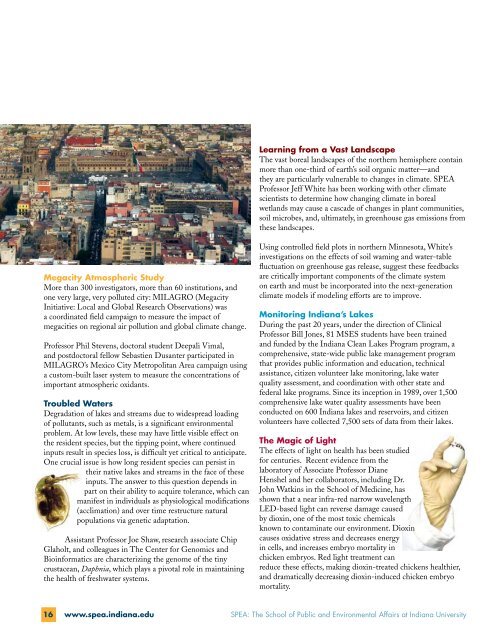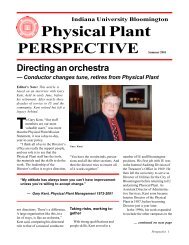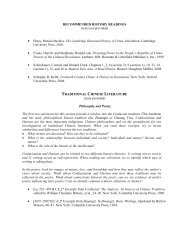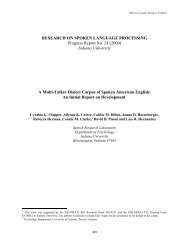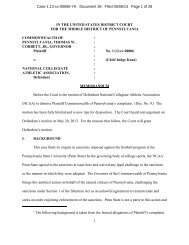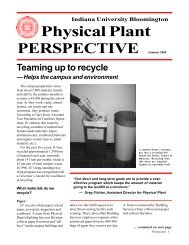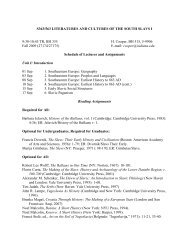Graduate Programs in Environmental Science - Indiana University
Graduate Programs in Environmental Science - Indiana University
Graduate Programs in Environmental Science - Indiana University
Create successful ePaper yourself
Turn your PDF publications into a flip-book with our unique Google optimized e-Paper software.
Learn<strong>in</strong>g from a Vast Landscape<br />
The vast boreal landscapes of the northern hemisphere conta<strong>in</strong><br />
more than one-third of earth’s soil organic matter—and<br />
they are particularly vulnerable to changes <strong>in</strong> climate. SPEA<br />
Professor Jeff White has been work<strong>in</strong>g with other climate<br />
scientists to determ<strong>in</strong>e how chang<strong>in</strong>g climate <strong>in</strong> boreal<br />
wetlands may cause a cascade of changes <strong>in</strong> plant communities,<br />
soil microbes, and, ultimately, <strong>in</strong> greenhouse gas emissions from<br />
these landscapes.<br />
Megacity Atmospheric Study<br />
More than 300 <strong>in</strong>vestigators, more than 60 <strong>in</strong>stitutions, and<br />
one very large, very polluted city: MILAGRO (Megacity<br />
Initiative: Local and Global Research Observations) was<br />
a coord<strong>in</strong>ated field campaign to measure the impact of<br />
megacities on regional air pollution and global climate change.<br />
Professor Phil Stevens, doctoral student Deepali Vimal,<br />
and postdoctoral fellow Sebastien Dusanter participated <strong>in</strong><br />
MILAGRO’s Mexico City Metropolitan Area campaign us<strong>in</strong>g<br />
a custom-built laser system to measure the concentrations of<br />
important atmospheric oxidants.<br />
Troubled Waters<br />
Degradation of lakes and streams due to widespread load<strong>in</strong>g<br />
of pollutants, such as metals, is a significant environmental<br />
problem. At low levels, these may have little visible effect on<br />
the resident species, but the tipp<strong>in</strong>g po<strong>in</strong>t, where cont<strong>in</strong>ued<br />
<strong>in</strong>puts result <strong>in</strong> species loss, is difficult yet critical to anticipate.<br />
One crucial issue is how long resident species can persist <strong>in</strong><br />
their native lakes and streams <strong>in</strong> the face of these<br />
<strong>in</strong>puts. The answer to this question depends <strong>in</strong><br />
part on their ability to acquire tolerance, which can<br />
manifest <strong>in</strong> <strong>in</strong>dividuals as physiological modifications<br />
(acclimation) and over time restructure natural<br />
populations via genetic adaptation.<br />
Assistant Professor Joe Shaw, research associate Chip<br />
Glaholt, and colleagues <strong>in</strong> The Center for Genomics and<br />
Bio<strong>in</strong>formatics are characteriz<strong>in</strong>g the genome of the t<strong>in</strong>y<br />
crustacean, Daphnia, which plays a pivotal role <strong>in</strong> ma<strong>in</strong>ta<strong>in</strong><strong>in</strong>g<br />
the health of freshwater systems.<br />
Us<strong>in</strong>g controlled field plots <strong>in</strong> northern M<strong>in</strong>nesota, White’s<br />
<strong>in</strong>vestigations on the effects of soil wam<strong>in</strong>g and water-table<br />
fluctuation on greenhouse gas release, suggest these feedbacks<br />
are critically important components of the climate system<br />
on earth and must be <strong>in</strong>corporated <strong>in</strong>to the next-generation<br />
climate models if model<strong>in</strong>g efforts are to improve.<br />
Monitor<strong>in</strong>g <strong>Indiana</strong>’s Lakes<br />
Dur<strong>in</strong>g the past 20 years, under the direction of Cl<strong>in</strong>ical<br />
Professor Bill Jones, 81 MSES students have been tra<strong>in</strong>ed<br />
and funded by the <strong>Indiana</strong> Clean Lakes Program program, a<br />
comprehensive, state-wide public lake management program<br />
that provides public <strong>in</strong>formation and education, technical<br />
assistance, citizen volunteer lake monitor<strong>in</strong>g, lake water<br />
quality assessment, and coord<strong>in</strong>ation with other state and<br />
federal lake programs. S<strong>in</strong>ce its <strong>in</strong>ception <strong>in</strong> 1989, over 1,500<br />
comprehensive lake water quality assessments have been<br />
conducted on 600 <strong>Indiana</strong> lakes and reservoirs, and citizen<br />
volunteers have collected 7,500 sets of data from their lakes.<br />
The Magic of Light<br />
The effects of light on health has been studied<br />
for centuries. Recent evidence from the<br />
laboratory of Associate Professor Diane<br />
Henshel and her collaborators, <strong>in</strong>clud<strong>in</strong>g Dr.<br />
John Watk<strong>in</strong>s <strong>in</strong> the School of Medic<strong>in</strong>e, has<br />
shown that a near <strong>in</strong>fra-red narrow wavelength<br />
LED-based light can reverse damage caused<br />
by diox<strong>in</strong>, one of the most toxic chemicals<br />
known to contam<strong>in</strong>ate our environment. Diox<strong>in</strong><br />
causes oxidative stress and decreases energy<br />
<strong>in</strong> cells, and <strong>in</strong>creases embryo mortality <strong>in</strong><br />
chicken embryos. Red light treatment can<br />
reduce these effects, mak<strong>in</strong>g diox<strong>in</strong>-treated chickens healthier,<br />
and dramatically decreas<strong>in</strong>g diox<strong>in</strong>-<strong>in</strong>duced chicken embryo<br />
mortality.<br />
16 www.spea.<strong>in</strong>diana.edu SPEA: The School of Public and <strong>Environmental</strong> Affairs at <strong>Indiana</strong> <strong>University</strong>


